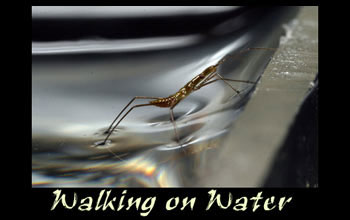News Release 05-171
For These Bugs, Walking on Water Is Easy
Getting out of the pond is the problem

View video
Many water-walking insects can't climb menisci using their traditional means of propulsion.
September 28, 2005
This material is available primarily for archival purposes. Telephone numbers or other contact information may be out of date; please see current contact information at media contacts.
A "meniscus"—the crescent-shaped and barely visible slope literally at water's edge—can mean life or death to an insect the size of a speck of dust. Water bugs that tiny must summon the energy to "surf" themselves up the problematic interface between liquid and solid in ponds and other wet places to escape predators or reproduce.
Menisci are all around us, "but we don't notice them because they're so small, only a few millimeters in height," said mathematician David Hu of the Massachusetts Institute of Technology. "But if you're a creature that's much smaller than that, those slopes "are like frictionless mountains," said Hu. "Plus, it's slippery."
Now, Hu and coworker John Bush have done the math to explain how nearly weightless water walkers find the traction to ascend a wall of water several times their height. Such obstacles, which are almost invisible to humans, may surround a leaf floating in a stream or a stone on the riverbank.
An article on the work appears in the Sept. 29 issue of the journal Nature.
According to Bush, the study, which was funded by the National Science Foundation, may be "of interest to people working in nanotechnology, because they, too, are concerned with problems at very small scales."
Read the full release from MIT at www.web.mit.edu/newsoffice/
-NSF-
Media Contacts
Leslie Fink, NSF, (703) 292-5395, email: lfink@nsf.gov
Elizabeth Thomson, MIT, (617) 258-5402, email: thomson@mit.edu
Related Websites
Meniscus-Climbing Insects web site: http://www-math.mit.edu/~dhu/Climberweb/climberweb.html
The U.S. National Science Foundation propels the nation forward by advancing fundamental research in all fields of science and engineering. NSF supports research and people by providing facilities, instruments and funding to support their ingenuity and sustain the U.S. as a global leader in research and innovation. With a fiscal year 2023 budget of $9.5 billion, NSF funds reach all 50 states through grants to nearly 2,000 colleges, universities and institutions. Each year, NSF receives more than 40,000 competitive proposals and makes about 11,000 new awards. Those awards include support for cooperative research with industry, Arctic and Antarctic research and operations, and U.S. participation in international scientific efforts.
Connect with us online
NSF website: nsf.gov
NSF News: nsf.gov/news
For News Media: nsf.gov/news/newsroom
Statistics: nsf.gov/statistics/
Awards database: nsf.gov/awardsearch/
Follow us on social
Twitter: twitter.com/NSF
Facebook: facebook.com/US.NSF
Instagram: instagram.com/nsfgov


